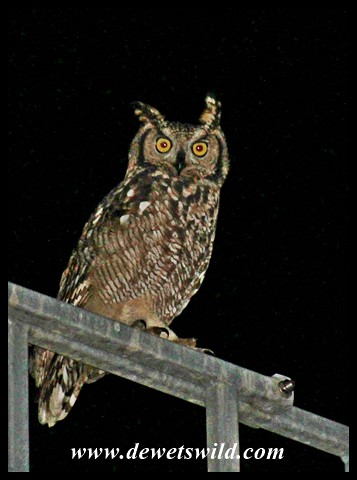Bubo africanus
The Spotted Eagle-owl is one of our most frequently encountered nocturnal birds, even in towns and cities where they can become quite confiding with humans (beware though that they will defend their nests ferociously!). They’re not very picky about their habitat and feed on an enormous variety of rodents and other small mammals, insects, reptiles, birds, fish, bats, frogs and carrion. Standing about 45cm high, with a wingspan of just over a metre and a weight of 700g the Spotted Eagle Owl is one of the smaller members of its family.
Spotted Eagle Owls breed at anytime of year, though peaking in spring and summer, and nesting in any suitable location be it in a concealed spot on the ground, or in a gully, tree or building (such as our local library’s gutters!) or somewhere else they find to their liking. Broods usually number two or three chicks, hatched after an incubation period lasting almost 5 weeks, but as many as six chicks have been recorded. Pairs are monogamous and while the female is responsible for incubating the clutch of eggs the male supplies her with food at the nest. Juveniles become fully independent about four months after leaving the nest, which happens about 5 weeks after they’ve hatched. Spotted Eagle Owls may live for about ten years in the wild and much longer in captivity.
The Spotted Eagle Owl occurs over virtually all of Africa south of the equator, with a separate population on the Arabian peninsula. The IUCN lists it as being of least concern. It is also a common species in South Africa and can be found in every province. Sadly they are often killed by vehicles when scavenging at road kills at night.















Pingback: Daphne the Spotted Eagle-owl | de Wets Wild
A beautiful bird! I liked your photo of it with the dark background. I saw their cousin, the Eurasian eagle owl, in Ireland earlier this year. Big bird.
LikeLike
They really are beautiful and impressive birds, Siobhan. Thank you.
LikeLiked by 1 person
They are lovely and your photos are remarkable as it is difficult to photograph nocturnal birds. I remember watching a pair hunting insects on the ground in the light of a suburban street light. Somehow as they walked about on the ground they resembled two-legged cats!
LikeLiked by 1 person
That’s a very accurate description, Carol – we’ve seen them on the ground on night drives and at a distance it is very difficult to discern them as owls – until they take off!
LikeLiked by 1 person
🙂
LikeLiked by 1 person
Great shots, Dries! Owls are the coolest creatures. Sad about the cars.
LikeLiked by 1 person
Thank you very much, Jane. We also love owls! They’re such magnificently beautiful birds; seeing one dead on the road is awful.
LikeLiked by 1 person
I remember having to slow down every time we pass the street just across our housing complex leading to the highway. There are owls standing in a row in the complete darkness. I spot them as soon as we draw near. They normally fly instantly, what a beauty! I don’t know what owl they belong to but I enjoy watching them sit in stillness and soon turn into a flock of flying birds. I have never heard of them killed by vehicles passing by. Hopefully will never.
LikeLike
I find owls absolutely fascinating. We have a pair living in our woods and I often hear them calling in the twilight hours. Mesmerizing…
LikeLiked by 1 person
Thanks, Lori! Being mesmerized by nature is just the medicine we need in this topsy-turvy world!
LikeLiked by 1 person
The chicks are adorable.
I enjoyed being serenaded by some sort of owl in the early morning hours as I had my coffee and quiet time. 🙂
LikeLiked by 1 person
What a wonderful way to start the day, Kathy!
LikeLike
I have fond memories of these owls: my father used to slow down at certain places on the dirt road that led to our farm when travelling at night for these were the regular spots where these owls were encountered. I love the sound of owls! Sadly, the widespread use of rat poison in urban areas has a negative effect on all owls that thrive on rats and mice. The Spotted Eagle Owls (I know of two in our area) have not been seen for some years now.
LikeLiked by 1 person
That is very, very sad, Anne and I hope that people will eventually learn that there’s much better ways to get rid of such pests (prevention is always better than cure to start with). We’re lucky to see and hear the Spotted Eagle-owls here in Garsfontein often, sometimes on our own roof, and I must not take that for granted!
LikeLiked by 1 person
Interesting! I have an owl in my backyard that I hear almost every night, but I’ve never seen it nor photographed. Can you believe that? I do not interfere with any bird’s lives. I don’t look for nests either. Your spotted eagle owl looks very alert and ready for action. Good shots. Thanks, D. 🙂
LikeLiked by 1 person
Thanks, H.J. Certainly the greatest joy is in observing nature without influencing it.
LikeLiked by 1 person
I will never understand drivers who do not slow down for ANYTHING that is in the street! That is a real shame.
LikeLiked by 1 person
Same here, Lois. There’s two ways of looking at it, equally horrible. Either they just aren’t paying attention, which means that dead owl could just as easily have been a person they ran over. Or, the fact that it was an animal made them care less.
LikeLike